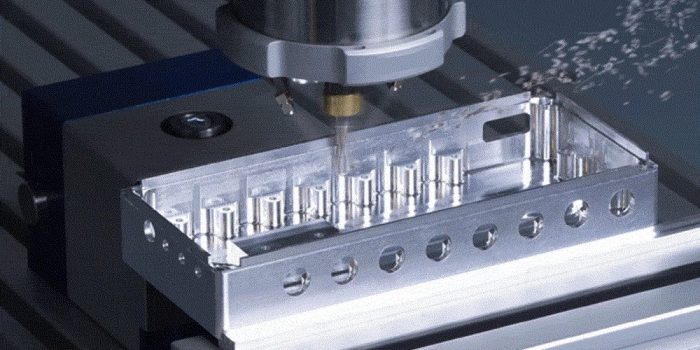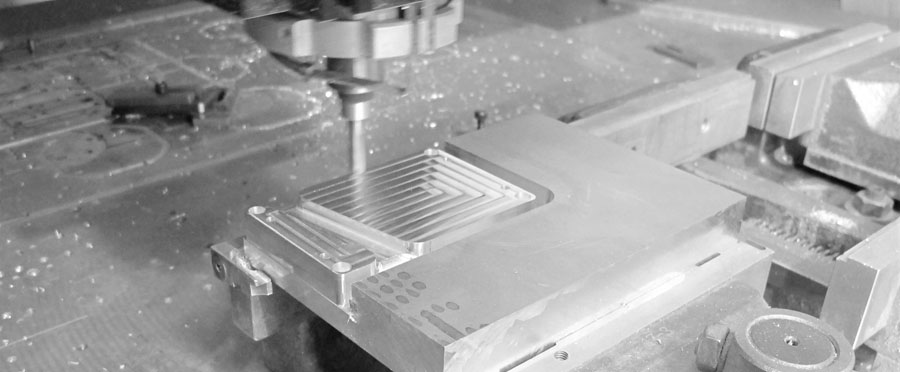There are many reasons for the deformation of aluminum parts, which are related to the material, the shape of the parts, and the production conditions. There are mainly the following aspects: deformation caused by internal stress of the blank, deformation caused by cutting force and cutting heat, and deformation caused by clamping force.
Tips To Reduce Aluminum Machining Deformation
1. Reduce The Internal Stress Of The Blank
Natural or artificial aging and vibration treatment can partially eliminate the internal stress of the blank. Pre-processing is also an effective process method. For the blank with fat head and big ears, due to the large margin, the deformation after processing is also large. If the excess part of the blank is pre-processed and the margin of each part is reduced, not only can the processing deformation of the subsequent process be reduced, but also a part of the internal stress can be released after pre-processed for a period of time.

2. Improve The Cutting Ability Of The Tool
The material and geometric parameters of the tool have an important influence on the cutting force and cutting heat. The correct selection of the tool is very important to reduce the deformation of the parts.
1) Reasonably Choose The Tool Geometry Parameters.
①The rake angle: Under the condition of maintaining the strength of the cutting edge, the rake angle should be appropriately selected to be larger. On the one hand, it can grind a sharp cutting edge, and on the other hand, it can reduce cutting deformation and smooth chip removal, thereby reducing cutting force and cutting temperature. Never use negative rake angle tools.
②Clear angle: The size of the relief angle has a direct effect on the wear of the flank surface and the quality of the machined surface. Cutting thickness is an important condition for selecting the relief angle. During rough milling, due to the large feed rate, heavy cutting load, and large heat generation, good heat dissipation conditions of the tool are required. Therefore, the clearance angle should be selected smaller. When finishing milling, the cutting edge is required to be sharp, to reduce the friction between the flank face and the machined surface, and to reduce the elastic deformation. Therefore, the relief angle should be selected larger.
③Helix angle: In order to make the milling smooth and reduce the milling force, the helix angle should be selected as large as possible.
④ Entering angle: Appropriately reducing the entering angle can improve the heat dissipation conditions and reduce the average temperature of the processing area.
2) Improve The Tool Structure.
①Reduce the number of teeth of the milling cutter and increase the chip space. Due to the large plasticity of the aluminum material, the larger cutting deformation during processing, and a larger chip holding space, the bottom radius of the chip pocket should be larger and the number of teeth of the milling cutter should be smaller.
② Finely sharpen the teeth of the knife. The roughness value of the cutting edge of the cutter tooth should be less than Ra=0.4um. Before using a new knife, you should lightly grind the front and back of the teeth with a fine oil stone to eliminate the residual burrs and slight serrations when sharpening the teeth. In this way, not only the cutting heat can be reduced, but also the cutting deformation is relatively small.
③Strictly control the wear standard of the tool. After the tool is worn, the surface roughness value of the workpiece increases, the cutting temperature rises, and the deformation of the workpiece increases. Therefore, in addition to the selection of tool materials with good wear resistance, the tool wear standard should not be greater than 0.2mm, otherwise it is easy to produce built-up edge. When cutting, the temperature of the workpiece should generally not exceed 100°C to prevent deformation.
3. Improve The Clamping Method Of The Workpiece
For thin-walled aluminum workpieces with poor rigidity, the following clamping methods can be used to reduce deformation:
①For thin-walled bushing parts, if a three-jaw self-centering chuck or spring chuck is used to clamp from the radial direction, once it is loosened after processing, the workpiece will inevitably be deformed. At this time, the method of pressing the axial end face with better rigidity should be used. Use the inner hole of the part to locate, make a self-made threaded mandrel, sleeve it into the inner hole of the part, and use a cover plate to press the end face on it, and then tighten it with a nut. When machining the outer circle, clamping deformation can be avoided, so that satisfactory machining accuracy can be obtained.
②When processing thin-walled and thin-plate workpieces, it is best to use vacuum suction cups to obtain evenly distributed clamping force, and then process with a small amount of cutting, which can well prevent the deformation of the workpiece.
In addition, a packing method can also be used. In order to increase the process rigidity of thin-walled workpieces, medium can be filled inside the workpiece to reduce the deformation of the workpiece during clamping and cutting. For example, pour a urea melt containing 3% to 6% potassium nitrate into the workpiece, and after processing, immerse the workpiece in water or alcohol to dissolve the filler and pour it out.
4. Reasonable Arrangement Of Procedures
During high-speed cutting, due to the large machining allowance and intermittent cutting, the milling process often produces vibration, which affects the machining accuracy and surface roughness. Therefore, the CNC high-speed cutting process can generally be divided into: rough machining-semi-finish machining-clear corner machining-finishing and other processes. For parts with high precision requirements, it is sometimes necessary to perform secondary semi-finishing and then finishing. After rough machining, the parts can be cooled naturally to eliminate internal stress caused by rough machining and reduce deformation. The margin left after rough machining should be greater than the amount of deformation, generally 1 to 2 mm. During finishing, the finishing surface of the part should maintain a uniform machining allowance, generally 0.2-0.5mm is appropriate, so that the tool is in a stable state during the machining process, which can greatly reduce cutting deformation, obtain good surface machining quality, and ensure The accuracy of the product.

Operation Skills To Reduce Processing Deformation
In addition to the above-mentioned reasons, aluminum parts deform during processing. In actual operation, the operation method is also very important.
- For parts with a large machining allowance, in order to have better heat dissipation conditions during the machining process and avoid heat concentration, symmetrical machining should be used during machining. If there is a 90mm thick sheet that needs to be processed to 60mm, if one side is milled and the other side is milled immediately, and the final size is processed once, the flatness will reach 5mm; if repeated feed symmetrical processing is used, each side is processed twice The final size can guarantee a flatness of 0.3mm.
- If there are multiple cavities on the plate part, it is not advisable to use the sequential processing method of one cavity one cavity during processing, which will easily cause uneven stress and deformation of the parts. Multi-layer processing is adopted, and each layer is processed to all cavities at the same time as much as possible, and then the next layer is processed to make the parts evenly stressed and reduce deformation.
- Reduce cutting force and cutting heat by changing the cutting amount. Among the three elements of cutting amount, the amount of back-cutting has a great influence on cutting force. If the machining allowance is too large, the cutting force of a pass is too large, which will not only deform the parts, but also affect the rigidity of the machine tool spindle and reduce the durability of the tool. If you reduce the amount of knives back, the production efficiency will be greatly reduced. However, high-speed milling is used in CNC machining, which can overcome this problem. While reducing the amount of back-grabbing, as long as the feed is increased correspondingly and the speed of the machine tool is increased, the cutting force can be reduced while ensuring the processing efficiency.
- The order of the knife should also be paid attention to. Rough machining emphasizes the improvement of machining efficiency and the pursuit of removal rate per unit time. Generally, up-cut milling can be used. That is, the excess material on the surface of the blank is removed at the fastest speed and the shortest time, and the geometric contour required for finishing is basically formed. The emphasis of finishing is high precision and high quality, and down milling should be used. Because the cutting thickness of the cutter teeth gradually decreases from the maximum to zero during down milling, the degree of work hardening is greatly reduced, and at the same time the degree of deformation of the parts is reduced.
- The deformation of thin-walled workpieces due to clamping during processing is difficult to avoid even for finishing. In order to reduce the deformation of the workpiece to the minimum, you can loosen the pressing piece before the finishing process reaches the final size, so that the workpiece can be restored to its original shape freely, and then slightly tighten it, whichever is the only way to clamp the workpiece (completely According to the feel), the ideal processing effect can be obtained in this way. In short, the point of action of the clamping force is best on the supporting surface, and the clamping force should act in the direction of good rigidity of the workpiece. Under the premise of ensuring that the workpiece does not loosen, the smaller the clamping force, the better.
- When machining parts with cavities, try not to let the milling cutter plunge directly into the part like a drill bit, resulting in insufficient chip holding space of the milling cutter, unsmooth chip removal, and overheating, expansion and collapse of the part. Unfavorable phenomena such as knives and broken knives. First, drill the hole with a drill of the same size as the milling cutter or one size larger, and then mill it with the milling cutter. Alternatively, the CAM software can be used to produce the spiral cutting program.
The main factor that affects the processing accuracy and surface quality of aluminum parts is that deformation is prone to occur during the processing of such parts, which requires operators to have certain operating experience and skills.


